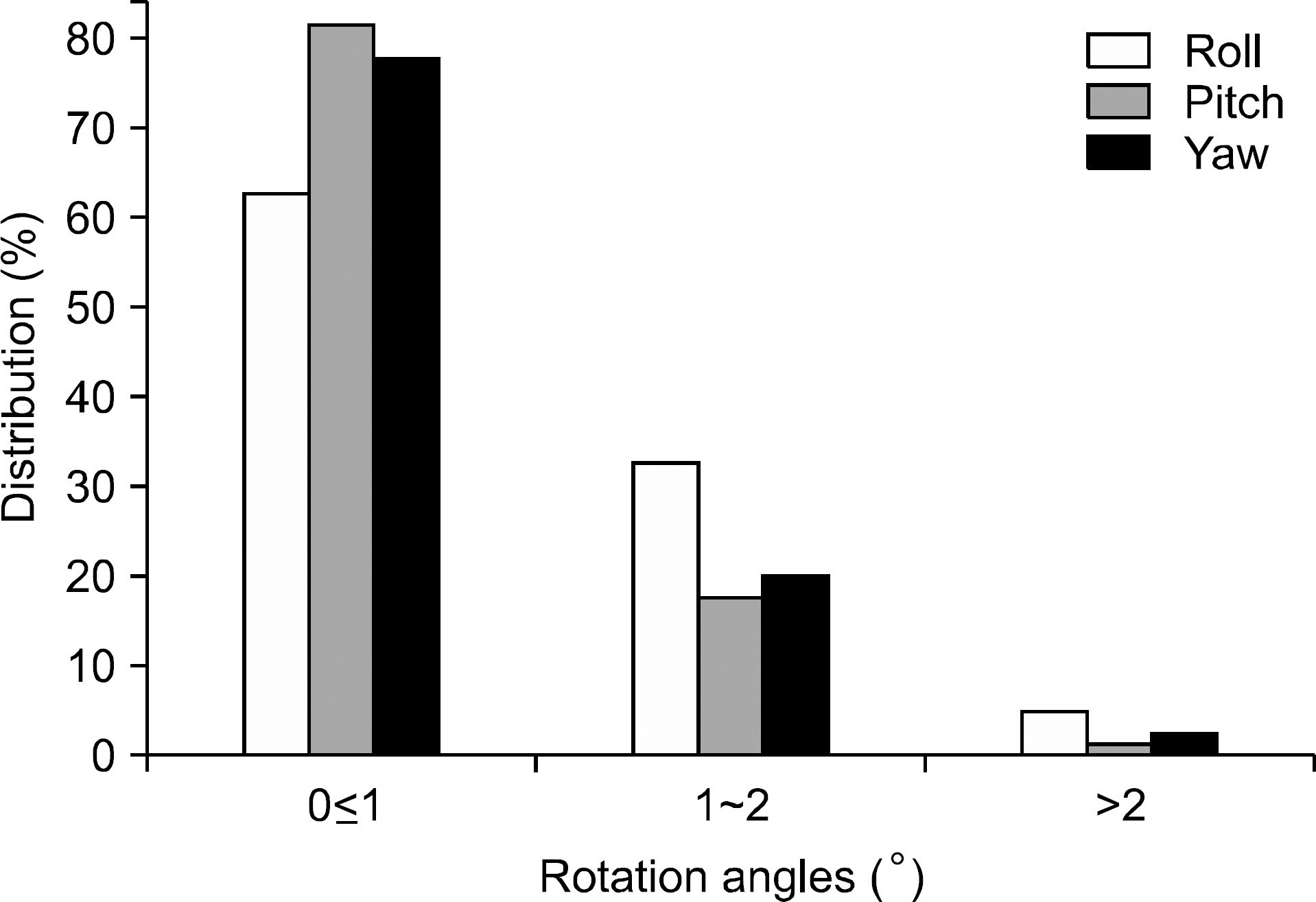Prog Med Phys.
2015 Mar;26(1):6-11. 10.14316/pmp.2015.26.1.6.
Rotation Errors of Breast Cancer on 3D-CRT in TomoDirect
- Affiliations
-
- 1Department of Radiation Oncology, College of Medicine, Soonchunhyang University of Korea, Bucheon, Korea. medphy@schmc.ac.kr
- 2Department of Radiation Oncology, Gachon University Gil Medical Center of Korea, Incheon, Korea.
- 3Department of Biomedical Engineering and Research Institute of Biomedical Engineering, The Catholic University of Korea, Seoul, Korea.
- KMID: 2315772
- DOI: http://doi.org/10.14316/pmp.2015.26.1.6
Abstract
- The purpose of this study was to analyze the rotational errors of roll, pitch, and yaw in the whole breast cancer treated by the three-dimensional radiation therapy (3D-CRT) using TomoDirect (TD). Twenty-patient previously treated with TD 3D-CRT was selected. We performed a retrospective clinical analysis based on 80 images of megavoltage computed tomography (MVCT) including the systematic and random variation with patient setup errors and treatment setup margin (mm). In addition, a rotational error (degree) for each patient was analyzed using the automatic image registration. The treatment margin of X, Y, and Z directions were 4.2 mm, 6.2 mm, and 6.4 mm, respectively. The mean value of the rotational error for roll, pitch, and yaw were 0.3degrees, 0.5degrees, 0.1degrees, and all of systematic and random error was within 1.0degrees. The errors of patient positioning with the Y and Z directions have generally been mainly higher than the X direction. The percentage in treatment fractions in less than 2degrees at roll, pitch, and yaw are 95.1%, 98.8%, and 97.5%, respectively. However, the edge of upper and lower (i.e., bottom) based on the center of therapy region (point) will quite a possibility that it is expected to twist even longer as the length of treatment region. The patient-specific characters should be considered for the accuracy and reproducibility of treatment and it is necessary to confirm periodically the rotational errors, including patient repositioning and repeating MVCT scan.
Keyword
MeSH Terms
Figure
Reference
-
References
1. Fields EC, Rabinovitch R, Ryan NE, Miften M, Westerly DC. A detailed evaluation of TomoDirect 3DCRT planning for whole-breast radiation therapy. Med Dosim. 38:401–406. 2013.
Article2. Chira C, Kirova YM, Liem X, et al. Helical tomothreapy for inoperable breast cancer: a new promising tool. Biomed Res Int. 2013:1–8. 2013.3. Jones R, Yang W, Read P, Sheng K. Radiation therapy of post-mastoectomy patients with positive nodes fixed beam tomotherapy. Radiother Oncol. 100:247–252. 2011.4. Langner UW, Molloy JA, Gleason JF Jr, Feddock JM. A feasibility study using TomoDirect for craniospinal irradiation. J appl Clin Med Phys. 14:104–114. 2013.
Article5. Klein M, Gaede S, Yartsev S. A study of longitudinal tumor motion in helical tomotherapy using a cylindrical phantom. J appl Clin Med Phys. 14:52–61. 2013.
Article6. Franco P, Catuzzo P, Cante D, et al. TomoDirect: an efficient means to deliver radiation at static angles with tomotherapy. Tumori. 97:498–502. 2011.
Article7. Boswell SA, Jeraj R, Ruchala KJ, et al. A novel method to correct for pitch and yaw patient setup errors in helical tomotherapy. Med Phys. 32:1630–1639. 2005.
Article8. Kaiser A, Schultheiss TE, Wong JY, et al. Pitch, roll, and yaw variations in patient positioning. Int J Radiat Oncol Biol Phys. 66:949–955. 2006.
Article9. Zhou J, Uhl B, Dewit K, et al. Analysis of daily setup variation with tomotherapy megavoltage computed tomography. Med Dosim. 35:31–37. 2010.
Article10. George R, Keall PJ, Kini VR, et al. Quantifying the effect of intrafraction motion during breast IMRT planning and dose delivery. Med Phys. 30:552–562. 2003.
Article11. Jain P, Marchant T, Green M, et al. Interfraction motion and dosimetric consequences during breast intensitymodulated radiotherapy (IMRT). Radiother Oncol. 90:93–98. 2009.
Article12. Reynders T, Tournel K, De Coninck P, et al. Dosimetric assessment of static and helical TomoTherapy in the clinical implementation of breast cancer treatments. Radiother Oncol. 93:71–79. 2009.
Article13. Goddu SM, Yaddanapudi S, Pechenaya OL, et al. Dosimetric consequences of uncorrected setup errors in helical Tomotherapy treatments of breast-cancer patients. Radiother Oncol. 93:64–70. 2009.
Article14. Furuya T, Sugimoto S, Kurokawa C, Ozawa S, Karasawa K, Sasai K. The dosimetric impact of respiratory breast movement and daily setup error on tangential whole breast irradiation using conventional wedge, field-in-field and irregular surface compensator techniques. J Radiat Res. 54:157–165. 2013.
Article15. van Herk M. Errors and Margins in Radiotherapy. Semi Int Radiat Oncol. 14:52–64. 2004.16. Kim YL, Cho KW, Jung JH, et al. Analysis of Automatic Rigid Image-Registration on Tomotherapy. Journal of Radiological Science and Technology. 37:37–47. 2014.17. Jassal K, Bisht S, Kataria T, Sachdev K, Choughle A, Supe S. Comparison of Geometrical Uncertainties in Breast Radiation Therapy with Different Immobilization Methods. J Nucl Med Radiat. 4:1–6. 2013.
Article
- Full Text Links
- Actions
-
Cited
- CITED
-
- Close
- Share
- Similar articles
-
- A Dosimetric Comparative Analysis of TomoDirect and Three-Dimensional Conformal Radiotherapy in Early Breast Cancer
- Setup Error and Effectiveness of Weekly Image-Guided Radiation Therapy of TomoDirect for Early Breast Cancer
- Analysis on the Dosimetric Characteristics of Tangential Breast Intensity Modulated Radiotherapy
- Small Bowel Sparing Effect of Small Bowel Displacement System in 3D-CRT and IMRT for Cervix Cancer
- Results of Three-Dimensional Conformal Radiation Therapy for the Treatment of a Solitary Sternal Relapse of Breast Cancer


